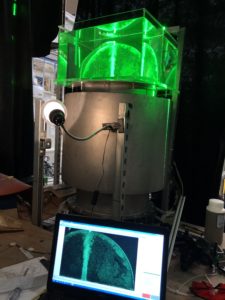The ASME V&V 30 Subcommittee on Verification and Validation in Computational Nuclear System Thermal Fluids Behavior is supporting a series of verification and validation (V&V) benchmark problems designed to study the scope and key ingredients of the V&V 30 Subcommittee’s charter. This will be achieved by means of the following:
- New, high-quality, state-of-the-art validation data sets obtained using a scaled down experimental facility and instruments with measurement uncertainties estimated using accepted ASME practices for experimental uncertainty (ASME PTC 19.1 Test Uncertainty)
- A stepwise, progressive approach characterized by focusing on each key ingredient individually
The second V&V benchmark problem, Single-Jet Computational Fluid Dynamics (CFD) Numeric Model Validation, in the series has been initiated for the 2019 V&V Symposium and involves simulating a single-jet and plume for single jet experiments at different Reynolds numbers.
The first V&V benchmark problem, Twin-Jet Computational Fluid Dynamics (CFD) Numerical Model, which ran from the 2016 V&V Symposium to the 2018 V&V Symposium, is now closed and a technical report is being written on the results.
Objective of the Second Problem:
Using a select set of data from the single-jet experiments (provided by the ASME and organizers), apply the V&V practices necessary to ensure an appropriately validated computational solution is obtained. The V&V 30 Subcommittee encourages participants from the nuclear community to use whatever V&V practices they would normally use in the context of preparing a document which they might submit to the U.S. Nuclear Regulatory Commission for review. A summary description of the second benchmark problem, including test geometry, boundary conditions for the isothermal single-jet experiments, and experimental data are accessible at the end of the page.

Protocol for Participating in the Second Problem:
The participating organizations or individuals who would like to take part in the benchmark exercise are requested to perform their V&V assessment using the standard protocol and procedures accepted by their engineering communities and sponsoring organizations. It is noted that this benchmark effort is not intended as a competition among companies or individuals, but rather is intended as a demonstration of the state of the practice in using and applying computational tools to support U.S. Nuclear Regulatory Commission or other regulatory reviews.
The outcomes of this second benchmark effort include lessons learned, review of V&V methods, and understanding of the effectiveness of V&V methods to support modeling and simulation reviews. The results of the various participants will be summarized and compared in a subsequent report.
The experimental data set produced by the Thermal-Hydraulic Research Laboratory, and information on experimental facility, are available for download from the link below.

